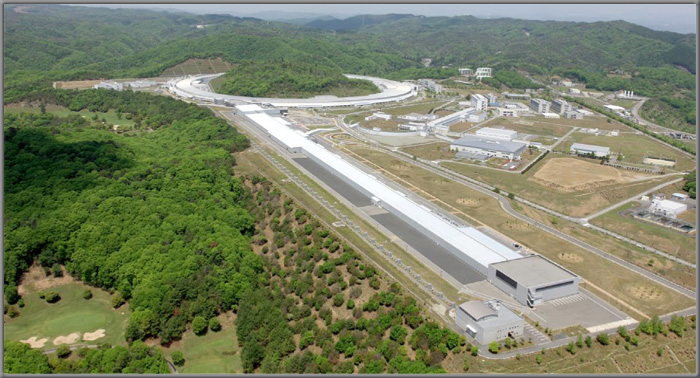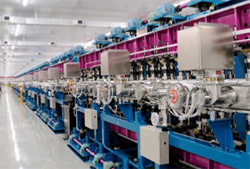Home > Highlighting JAPAN > Highlighting Japan JUNE 2012 > Dream Beam Comes True
Highlighting JAPAN
COVER STORY: Life Innovation for the World

SACLA (linear facility) and SPring-8 (circular facility), at RIKEN Harima Institute, Hyogo Prefecture
Credit: COURTEY OF RIKEN
Dream Beam Comes True
In March 2012, the RIKEN Harima Institute's SACLA finally commenced public operation. The facility produces X-ray Free Electron Laser with the world's shortest wavelength, 0.063 nm (nanometer = one billionth of a meter). Takashi Sasaki asked Dr. Tetsuya Ishikawa, director of the Institute, about the potential of "the dream beam" that shines light on the unknown world.

High-energy electrons are passed through a series of alternating magnets known as "undulators," whereupon they emit light in SACLA.
Credit: COURTEY OF RIKEN
The scientific community had been advocating the theoretical potential of XFEL since the 1980s. However, as numerous arduous hurdles had to be overcome before this could be realized, it was called the "the dream light."
SACLA (short for SPring-8 Angstrom Compact Free Electron Laser) of the RIKEN Harima Institute in Harima Science Garden City, Hyogo Prefecture, was the second XFEL-producing facility in the world to commence operation. Construction of SACLA began in 2006 as a Key Technology of National Importance. It was completed in FY2011 and brought to the adjustment stage, where for the first time in the world it broke the barrier of the 1 angstrom wavelength (0.1 nm). From March this year the facility was brought into operational use and made widely available to researchers.
"One of the features of SACLA is that the facility as a whole is very compact. With the collaboration of over 300 Japanese companies, we have created everything from the equipment for producing X-ray lasers to the building, using carefully selected materials, sophisticated technology, and an extremely high degree of precision," says Director Tetsuya Ishikawa.
The X-ray free-electron laser facility operating in the United States is approximately two kilometers long, while the one under construction in Germany is approximately 3.4 kilometers long. The length of SACLA is 700 meters.
Naturally, a smaller facility enables the construction period and construction costs to be kept low. The construction and planning of XFEL facilities, classed as government projects, is now underway around the world. SACLA, which is compact and was completed on a low budget, may be regarded as a major influence.
Twenty-five research projects are currently being carried out at SACLA, solicited from both Japan and overseas. Fields such as the structural analysis of protein and the clarification of the structure of living cells, or the observation of the ultrahigh speed movement of electrons and atoms, show great promise.
One prospective field is basic research related to drug development. The human body consists of several tens of thousand kinds of proteins, of which approximately thirty percent are membrane proteins attached to the biomembrane of cells or organelles such as nuclei and mitochondria. While more than half of over-the-counter drugs target these membranes protein, little was known about their structures. However, by using SACLA we are actually able to see the live cell structure. This allows us to verify how the drug functions in the membrane protein, enabling us to produce drugs with high therapeutic efficacy.
"Things that mankind has until now been unable to see are now visible, and we cannot predict what kind of discoveries or result will be generated from this," says Dr. Ishikawa.
Moreover, during the course of the next two years it is planned to directly connect SACLA's data analysis system to the world's fastest supercomputer K computer located on Kobe Port Island, which will further accelerate the speed of the research. More than two months after it went into operational use, tangible research findings have yet to be announced. However, as a result of "the dream light" that shines light on the unknown world, a succession of Nobel Prize-caliber discoveries and inventions is by no means any longer a dream.
© 2009 Cabinet Office, Government of Japan






